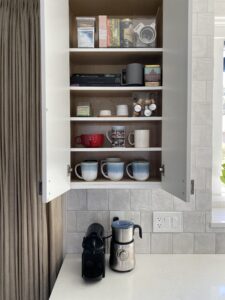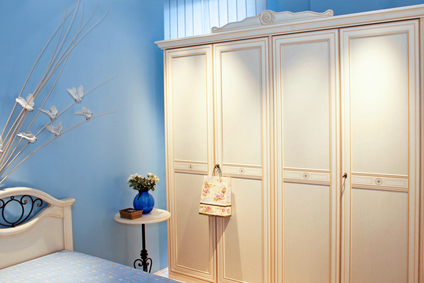
Are you growing tired of reorganizing your closet, kitchen, or desk drawers over and over again?
Or not sure where to begin with your closet purge?
Well here’s the truth…
You don’t actually need to be organizing every day of the week.
There, now quit the self guilt!
Organizing a room is the same as any other project you take on. Every project has a beginning and an end, with some scheduled steps in-between. It’s that easy.
One of the most asked questions I hear from friends and clients is “how can I motivate myself to organize the house?” The runner-ups are how to stay motivated, avoid procrastinating, and stop feeling guilty when “stuff” keeps piling up.
Well, we’re all busy these days and being pulled in many directions! Sometimes it’s our own fault for saying yes when we really want to say no, and the result of this is too much to do and not enough time to get it done. Which can make us feel resentful, frustrated, overwhelmed, and just plain tired.

Enough Already
If the piles of clutter are driving you crazy and you’re drained from looking at the mess, it’s a sign that you’re causing yourself a lot of unnecessary stress, anxiety, and overwhelm. The physical clutter is also keeping your mind cluttered.
When you keep your whole to-do list and all of your dreams, goals, and projects in your head, you will begin to feel overwhelmed and therefore unmotivated. And worse yet – you won’t be able to see the steps you’ve taken toward your organizing project!
Measuring your progress is critical to your organizing success and motivation!
The key to getting and staying motivated with your organizing project is to not skip the first step in the organizing process. You need to see the progress as it happens. There have been times when I’ve glazed over this step and have not written it down on paper. And consequently, I have lost all interest and moved onto the next exciting idea because it just sounds much better. Don’t fall into the trap of the bright, shiny object syndrome or starting lots of different organizing projects at once.

First Step to Organizing Anything
The first step to getting organized is creating a visual of what you want your newly organized space to look like. You need to get it out of your head and onto real paper. Print a photo or cut out a magazine image of what you want the space to look like and write out a few words that describe how you want your space to look, smell, or feel. (Need some inspo? Check out our Pinterest!) For example,
“My bedroom is my sanctuary.”
“The family room is clutter-free and it is pleasant to have guests over.”
“Preparing meals is a breeze.”
“I love walking into my office to a clean desk every morning.”
“I can quickly find any papers when I need them.”
“My computer files are fast to retrieve.”
Using an image makes the project even more motivating because you can see it throughout the whole process and it also helps your brain to stay focused on the goal.
If you’re someone who thinks everything needs to be stored inside your brain or computer – give your mind a break, go get out your colored felt pens and a piece of paper and just be creative for 10 minutes. Most of us are visual and love pen-to-paper time. So go for it and draw or write down what your organizing goal is. Now!
Next, post the visual organizing goal on a wall, fridge, or somewhere you will see it every day. Every time you look at your organizing goal, you’ll be inspired and motivated to take the next action step!
Chunking Down Your Projects
The next step is writing down all the action steps that you or someone else needs to do to get your organizing project complete. Type it out or write on paper, either way is ok. Just get it out of your head so organizing your chosen space isn’t going to be overwhelming.
To increase your motivation and really get inspired, estimate how long you think each action step will take; 10 minutes, 20, 45, 60, etc. Chunking your project down into bite-sized action steps increases your success rate and will keep you motivated because you will actually see the progress as your list gets crossed off!
Next, schedule three action steps in your calendar and make sure you hold yourself to these appointments. Don’t be afraid to enlist a friend to hold you accountable if you need a little extra push!
If something more interesting comes up and you’re about to ditch your 20 minute organizing session, look at your visual organizing goal and ask yourself if it’s worth procrastinating and putting it off. If the answer is yes, reschedule your 20 minute session. And if you’re too tired to stick to your schedule, decide to take 10 minutes now and do it anyways! You’ll feel less guilty (and actually more motivated!) because you’ve done something to move your organizing project forward.
Getting Organized Does Not = Perfection
Let go of all thoughts perfectionism. Organizing isn’t about having everything perfect all the time! Start by aiming for easy to access and easy to put away.
No Cookie Cutter Solutions
And one last piece of wisdom for staying motivated with your organizing projects: “There is no one-size-fits-all solution to getting organized, and no cookie cutter solutions here at Simply Productive. Because one size does not fit all. There are key foundational organizing principles you need to know, yes, but then organizing systems and processes are personalized so they work for you!”
My intention is to inspire, educate, and teach you about creating organizing systems and processes that work for your home and workspace. So you have less stress and more free time for what’s important to you!
Now go and create your organizing goals right away, and post them in the comments section below!

 Clean
Clean